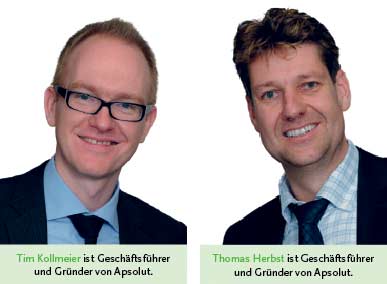The strategy decides
![[shutterstock.com:345979868, a-image]](https://e3mag.com/wp-content/uploads/2017/06/shutterstock_345979868_green_CMYK.jpg)

German SMEs are continuously driving economic growth in the country. Many regional companies have made the leap onto international markets in recent years and noticeably increased their employee numbers in the process.
However, the internal organizational and process structure does not always keep pace with the rapid expansion. Jean-Paul Wehrens, who is responsible for strategic business processes as a partner at IT consultancy firm Apsolut, reports:
"Unfortunately, in practice we often find that silo thinking and isolated solutions dominate instead of standardized business processes and IT systems across countries."
Purchasing organizations are also suffering from this situation. On the one hand, concentration trends on the procurement market and increasing competitive pressure make it necessary for procurement to take on an increasingly value-adding function in companies.
Maintaining and strengthening supplier relationships in particular is becoming increasingly important in order to improve delivery quality and reduce procurement risks and operational process costs.
On the other hand, the potential of supplier management with SAP cannot be exploited in many medium-sized companies because important organizational, structural and functional requirements are missing.
To counter these deficits, companies should combine a planned implementation project with several measures.
To successfully plan and implement SAP supplier management, all relevant measures must first be defined and coordinated across departments and countries: This is the only way to achieve company-wide acceptance of the new system-supported business processes.
To this end, a core team of representatives from all departments involved should be formed and a common understanding of the added value that the future solution should achieve should be developed. Management is also required to support the new supplier management strategy and communicate it to employees.
The second step is to derive the target processes from the supplier management strategy, in line with the company's purchasing and IT strategy.
To ensure the smooth implementation of the new processes, a change management system should be installed that systematically prepares employees for their new roles and tasks in the strategic management of suppliers.
In order to improve coordination processes in the long term, it is advisable to set up fixed interface functions between IT and purchasing. This is particularly essential in medium-sized companies, where communication between the two departments often only takes place on demand.
It is also advisable to bring all future core and key functions together in one place in a central purchasing department. If the new supplier management processes are installed, it must be ensured that they interact seamlessly with the adjacent purchasing processes, for example with tenders, auctions, contract management, reporting, the distribution of data in backend systems and the creation of comprehensive supplier portals.
When selecting a system, IT managers should pay attention not only to the range of functions but also to seamless integration into the company's strategy, process and IT environment.
"On premise or cloud?"
This is the question asked by many companies planning to introduce SAP supplier management.
The fact is that the skepticism that existed in German companies towards this procurement model just a year ago has largely disappeared, including in SAP-based procurement. Comprehensive security concepts have helped to reduce the widespread fear of data theft and manipulation in the cloud.
On the other hand, SAP has been working hard to add the functions and integration options of the Ariba cloud solutions that were initially still missing to the existing SAP system landscapes.
In the new Business Suite S/4, the aim is to integrate Ariba solutions into the SAP backend systems as far as possible. But which reference model is best suited to which users?
Jean-Paul Wehrens from Apsolut advises companies to combine on-premise and cloud solutions in hybrid environments that are tailored to their individual requirements:
"This allows users to combine the best of both worlds, namely to benefit from the advantages of Ariba solutions without having to convert their existing SAP systems and give up their investments."
The cloud-based Ariba solutions are fully in line with the trend towards lean best-practice processes, which offer companies only limited scope for expansion, but more effective and efficient procurement processes.
Master data is the linchpin for a smooth start to supplier management with SAP. Companies should therefore take care of the cross-location harmonization of information in a global SAP system at an early stage.
"Every master data project must start some time before the actual supplier management project and then run parallel to it"
Jean-Paul Wehrens outlines the ideal time frame.
In concrete terms, this means In order for a company to start with a cleansed supplier master, the master data must be harmonized by the time SAP Supplier Management goes live at the latest.
This also enables existing suppliers to take over a significant part of the master data maintenance themselves, while new suppliers are qualified by the purchasing organizations via their master data and distributed to the adjacent SAP systems. Structured workflows ensure that the information is effectively enriched, distributed and updated.






